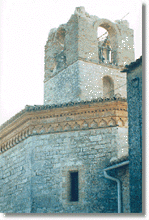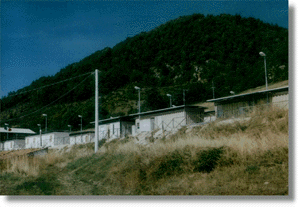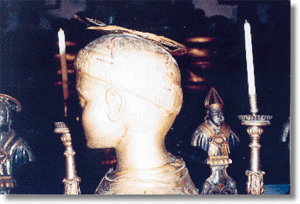By Maria Rita Parroni Marzetti
Like a phoenix rising from the ashes, Volperino, on the feast day of its patron saint, Saint Maron, arose again in praise and celebration! It has been the tradition of this village to celebrate the feast of Saint Maron on August 17 and 18 of every year since the twelfth century. This year the feast was tinged with sadness for it was the first anniversary after the 1997 earthquake, which ravaged the town and the whole region of Umbria. The Mass and the celebrations took place outside the damaged church
of Saint Maron. Instead of coming out of their homes, the people of Volperino
left their tents and car caravans because their homes had been severely
damaged by the tremors. The atmosphere was sad but emanated faith, courage
and hope. Saint Maron has such an effect on people, whether in Lebanon
or in Volperino, that his followers are firm-willed.
One year ago this fall, repeated earthquakes devastated the region of
Umbria. Many villages and towns were greatly damaged if not completely
destroyed. Volperinoís church and homes suffered enormous damage.
On the night of August 17, Father Umberto, our village priest, brought the skull of Saint Maron in its reliquary to Volperino from Foligno where it is housed. A large crowd followed the relic in a procession in Volperino. The procession did not move through the village as in the past because most sections of the village are off-limits because of the danger posed by the damaged structures. They stayed close to the church and the housing provided for the people of Volperino. Near the church the people prayed to the Lord with hearts that were broken yet open and receptive. The words of Father Umberto Formica touched all those gathered and reminded them of the wonderful feasts, celebrations and processions held in happier times. On Saint Maronís feast day on August 18, Father Umberto celebrated an open air High Mass attended by four priests who were former rectors of Saint Maronís church: Fathers Gianni Nizzi, Dino Ambrogi, Giuseppe and Domenico. Also attending were the Mayor of Foligno, Avv.Maurizio Salari, and several people from Valdarno, a small area of Tuscany which helped Volperino during the emergency following the devastation. Volperino is a village in the Umbria region of Italy. The history of Saint Maron and Volperino became intertwined in the twelfth century when the holy skull of the Saint was brought as a relic from the East. According to oral and written history, Michel degli Atti, a noble and then Count of Oppello in the Foligno District, was abbot of the Holy Cross Monastery of Sassovivo. He was one of a large number of Crusaders from Foligno who came to the East to rescue Christ's holy sepulcher from the Muslims. Upon his return to Italy in 1130 A.D., crusader Count Michel brought with him a very precious cargo -- the skull of Saint Maron. Count Michel promoted reverence for Saint Maron --rendered as Saint Mauro from Italian-- and his relic to such an extent that a great devotion to the saint sprang up throughout all of Italy and spread to Eastern Europe. For centuries, Volperino was the scene of great pilgrimages during the saintís feast day in August. Since Volperino was part of Count Michel's feudal holdings, it became the center of the religious devotion, especially after the village built a church in the name of the honored saint and adorned with several frescos depicting the Patron Saint. Consequently, Michel gave Saint Maron's relic to the new church. The first available reference to the church of St. Mauro (Maron) was made in the Bull of Pope Innocent II of 1138 A.D. In 1490, Bishop Luca Cibo [also spelled Cybo] decided to honor even more the relic of Saint Maron. He appropriated it from the people of Volperino and had it placed among the sacred relics in Saint Felicianoís Cathedral in Foligno. The precious relic was then placed in a valuable silver reliquary. Its fine workmanship, dating to the fifteenth century, is the work of Foligno goldsmith Roscetto who was a student of fifteenth-century engraver, goldsmith and minter Emiliano Orfini. Although the relic remains housed to this day in the Cathedral in Foligno for viewing by request, it is returned to Volperino for veneration every year on the feast of the saint in August. This year's two days celebration of Saint Maron's feast brought mixed feelings to all the people of Volperino and the area. They remembered how Volperino was before the quake and after it. There is the danger that the village will fall into obscurity and be forgotten if only large churches and cathedrals are repaired but not the small churches like Saint Maronís. The bishop is waiting for donations from the state and from other contributors to make the repairs. Without the church there will be no village and the thousand-year devotion to Saint Maron will cease. This past August, the people of Volperino prayed to Saint Maron for his help in rebuilding their small village as a place of communal love, faith and hope again and a place where he is honored and where his relic is revered. If you are ever in Italy during the month of August, come and celebrate Saint Maron's day with the "Maronites" of Volperino. |



